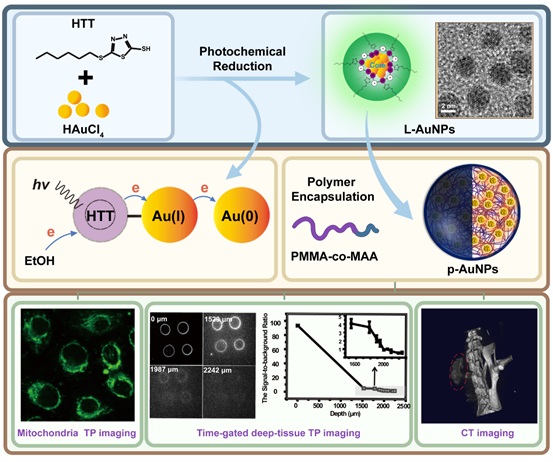Gold nanoparticles (AuNPs) are noble metal nanomaterials with unique physicochemical properties, easy functional modification and superior biocompatibility, which have been widely utilized in bio-sensing, bio-imaging, disease diagnosis, cancer treatment and other fields. Luminescent gold nanoparticles (L-AuNPs) larger than 2 nm are a new class of luminescent materials with excellent performance that have been developed in recent years and are of great value in the field of biomedical imaging. However, the synthesis strategy of L-AuNPs is mainly based on the thermal reduction method, which is complicated and labor-intensive; the high equipment and energy consumption requirements under high temperature conditions and the safety risks of some reducing agents, such as toxicity or flammability and explosivity; and the low luminescence efficiency of L-AuNPs prepared by the thermal reduction method, which severely limit their applications in biomedicine. These are serious limitations for their application in biomedicine.
JIANG Yuqiang’s Research Group from the Institute of Genetics and Developmental Biology, Chinese Academy of Sciences, in collaboration with Peking University, First Affiliated Hospital of Naval Medical University (Shanghai Changhai Hospital), Institute of Acupuncture and Moxibustion, Chinese Academy of Traditional Chinese Medicine, and Renmin University of China, developed a facile photochemical route for the preparation of luminescent gold nanoparticles encapsulated on the surface of 2-n-hexylthio-1,3,4-thiadiazole-5-thiols (HTT) (L-AuNP@HTT) with excellent luminescence properties.
The experimental results indicate that these prepared L-AuNP@HTT with a diameter of 3.19 nm exhibit excellent photoluminescence (PL) properties: high quantum yield (φ, 12.9%), ultra-long luminescence lifetime (~ 1 μs), symmetric PL curve profiles, and narrow full width at half maximum (FWHM, ≤ 49 nm), among others.
They also exhibit exceptionally large two-photon absorption (TPA) cross sections (σ) of up to 8.0 × 104 GM (1 GM = 10-50 cm4 s photo-1). After further polymer encapsulation treatment (i.e. p-AuNPs), the TPA cross section per particle can be further increased to 1.1 × 108 GM, which is much higher than that of conventional fluorescent dyes such as Rhodamine and FITC (generally <102 GM).
In addition, these prepared p-AuNPs were found to have excellent photostability and efficient mitochondrial targeting. High-quality mitochondria-targeted two-photon excited luminescence (TPEL) imaging, time-gated delayed imaging of deep tissues and in vivo computed tomography (CT) imaging have been successfully achieved based on these above p-AuNPs.
These results pave the way for the facile synthesis of high performance luminescent gold nanoparticles for a wide range of bio-imaging applications.
This study was recently published in the journal Advanced Composites and Hybrid Materials (DOI: 10.1007/s42114-024-00964-w) under the title 'Highly luminescent gold nanoparticles prepared via a facile photochemical method for bioimaging applications'.
This research was supported by the National Natural Science Foundation of China, the Strategic Pilot of the Chinese Academy of Sciences and the Sanya Yazhou Bay Science and Technology City Research Project.
Novel Facile Photochemical Synthesis of Highly Efficient Luminescent Gold Nanoparticle and its Applications in Bioimaging (Image by IGDB).
Contact:
Prof. JIANG Yuqiang
Institute of Genetics and Developmental Biology, Chinese Academy of Sciences
E-mail: yqjiang@genetics.ac.cn
 Novel Facile Photochemical Synthesis of Highly Efficient Luminescent Gold Nanoparticle and its Applications in Bioimaging (Image by IGDB).Contact:Prof. JIANG YuqiangInstitute of Genetics and Developmental Biology, Chinese Academy of SciencesE-mail: yqjiang@genetics.ac.cn
Novel Facile Photochemical Synthesis of Highly Efficient Luminescent Gold Nanoparticle and its Applications in Bioimaging (Image by IGDB).Contact:Prof. JIANG YuqiangInstitute of Genetics and Developmental Biology, Chinese Academy of SciencesE-mail: yqjiang@genetics.ac.cn CAS
CAS
 中文
中文




.png)
